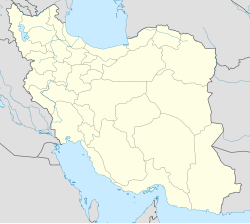HR 8768
HR 8768| 관측 데이터 Epoch J2000.0 이쿼녹스 J2000.0 | |
|---|---|
| 별자리 | 안드로메다 |
| HR 8768 A | |
| 우측 상승 | 23h 02m 45.14786s[1] |
| 탈위임 | +44° 03′ 31.4984″[1] |
| 겉보기 크기 (V) | 6.37[2] |
| HR 8768 B | |
| 우측 상승 | 23h 02m 45.60328s[3] |
| 탈위임 | +44° 03′ 37.2673″[3] |
| 겉보기 크기 (V) | 9.88[4] |
| 특성. | |
| 스펙트럼형 | B2V[5] |
| 겉보기 크기 (U) | 5.8[6] |
| 겉보기 크기 (B) | 6.377[7] |
| 겉보기 크기 (J) | 6.368[8] |
| 겉보기 크기 (H) | 6.482[8] |
| 겉보기 크기 (K) | 6.496[8] |
| 변수형 | 의심스러운[5] |
| 아스트로메트리 | |
| HR 8768 A | |
| 방사 속도 (Rv) | -11.30±0.1km[9]/s |
| 고유 운동 (μ) | RA:0.441±0.019[1]mas/yr Dec.:−5.799±0.027[1]mas/yr |
| 시차 (π) | 2.1847 ± 0.0280[1] 마스 |
| 거리 | 1,490 ± 20 리 (458 ± 6 pc) |
| 절대치수 (MV) | -1.66[10] |
| HR 8768 B | |
| 고유 운동 (μ) | RA:0.238±0.012[3]mas/yr Dec.:−5.813±0.016[3]mas/yr |
| 시차 (π) | 2.2005 ± 0.0182[3] 마스 |
| 거리 | 1,210 ± 10 ly (454 ± 4 pc) |
| 세부 사항 | |
| 미사 | 6.5[11] M☉ |
| 루미도 | 1,959[10] L☉ |
| 표면 중력 (log g) | 3.94±0.13[11] cgs |
| 온도 | 18090±730[11] K |
| 회전 속도 (v sin i) | 8±4km[11]/s |
| 나이 | 9.5±4.8[12] 마이어 |
| 기타 지정 | |
| 데이터베이스 참조 | |
| 심바드 | 자료 |
HR 8768은 LN 안드로메다자리라고도 알려져 있으며, 이전에 안드로메다자리에 있는 것으로 의심되는 변광성이다[5]. 지구에서 약 458파섹(1,490 ly) 떨어진 곳에 위치해 [1]겉으로 보이는 시각적 크기 6.41로 빛나므로 매우 유리한 조건에서 육안으로 볼 수 있다. 그것의 스펙트럼 분류는 B2V로, 그것은 18,090K의 유효 온도에서 대략 흑체 스펙트럼으로 빛을 방출하는 뜨거운 주계열성임을 의미한다.[11]
동반자
워싱턴 더블스타 카탈로그에서 HR 8768에는 HR 8768에서 7.5㎞[4] 떨어진 외관상 규모 9.88의 희미한 광학 동반성이 있다. 분리는 1828년 2중으로 발견되었을 때 4.0㎝에서 증가했다.[13] 두 별은 같은 히파르코스 식별자 HIP 113802를 공유하고 있으며 시차(paralax)와 적절한 동작을 가지고 있다.[1][3]
변동성
1979년 HR 8768의 파란색 크기는 매 28분마다 약 0.025씩 차이가 나는 것으로 보고되었다. 그러한 변동성은 어떤 종류의 변수에 대해서도 알려져 있지 않았지만, β 세페이 항성과 같은 불안정 스트립의 주 시퀀스(저조도) 끝에서 헤르츠스프룽-러셀 다이어그램의 위치가 높은 오베르톤 방사형 펄스를 발생시킬 가능성이 있는 원인이다.[10] 후속 연구는 동일한 빠른 변화, 또는 밝기의 중요한 변화를 찾지 못했다.[14] 그러나, HR 8768은 LN 안드로메다자리로서 가변 별의 일반 카탈로그에 추가되었다.[5]
히파르코스 광도계에 대한 분석은 주기가 3.25d인 약 0.0059개의 규모의 변동성을 보여준다. 이러한 변동에 대한 통계적 임계값은 별의 0.01%만 만족하는 수준에 있다.[2]
참조
- ^ a b c d e f g 이 소스에 대한 Brown, A. G. A.; et al. (Gaia collaboration) (2021). "Gaia Early Data Release 3: Summary of the contents and survey properties". Astronomy & Astrophysics. 649: A1. arXiv:2012.01533. Bibcode:2021A&A...649A...1G. doi:10.1051/0004-6361/202039657. S2CID 227254300.Gaia EDR3 레코드 VizieR.
- ^ a b Koen, Chris; Eyer, Laurent (2002). "New periodic variables from the Hipparcos epoch photometry". Monthly Notices of the Royal Astronomical Society. 331 (1): 45. arXiv:astro-ph/0112194. Bibcode:2002MNRAS.331...45K. doi:10.1046/j.1365-8711.2002.05150.x.
- ^ a b c d e f Brown, A. G. A.; et al. (Gaia collaboration) (2021). "Gaia Early Data Release 3: Summary of the contents and survey properties". Astronomy & Astrophysics. 649: A1. arXiv:2012.01533. Bibcode:2021A&A...649A...1G. doi:10.1051/0004-6361/202039657. S2CID 227254300. 이 소스에 대한 Gaia EDR3 레코드 VizieR.
- ^ a b "BD+43 4378B". SIMBAD. Centre de données astronomiques de Strasbourg. Retrieved November 15, 2018.
- ^ a b c d N. N. Samus; O. V. Durlevich; et al. "LN And database entry". Combined General Catalog of Variable Stars (2017 ed.). CDS. Retrieved 2018-11-12.
- ^ Reed, B. C. (May 2003). "Catalog of Galactic OB Stars". The Astronomical Journal. 125 (5): 2531–2533. Bibcode:2003AJ....125.2531R. doi:10.1086/374771.
- ^ "HR 8768". SIMBAD. Centre de données astronomiques de Strasbourg. Retrieved November 15, 2018.
- ^ a b c Cutri, Roc M.; Skrutskie, Michael F.; Van Dyk, Schuyler D.; Beichman, Charles A.; Carpenter, John M.; Chester, Thomas; Cambresy, Laurent; Evans, Tracey E.; Fowler, John W.; Gizis, John E.; Howard, Elizabeth V.; Huchra, John P.; Jarrett, Thomas H.; Kopan, Eugene L.; Kirkpatrick, J. Davy; Light, Robert M.; Marsh, Kenneth A.; McCallon, Howard L.; Schneider, Stephen E.; Stiening, Rae; Sykes, Matthew J.; Weinberg, Martin D.; Wheaton, William A.; Wheelock, Sherry L.; Zacarias, N. (2003). "VizieR Online Data Catalog: 2MASS All-Sky Catalog of Point Sources (Cutri+ 2003)". CDS/ADC Collection of Electronic Catalogues. 2246: II/246. Bibcode:2003yCat.2246....0C.
- ^ Gontcharov, G. A. (November 2006). "Pulkovo Compilation of Radial Velocities for 35 495 Hipparcos stars in a common system". Astronomy Letters. 32 (11): 759–771. arXiv:1606.08053. Bibcode:2006AstL...32..759G. doi:10.1134/S1063773706110065. S2CID 119231169.
- ^ a b c Jakate, S. M. (1979). "A new class of early-type ultra-short-period variables". The Astronomical Journal. 84: 1042. Bibcode:1979AJ.....84.1042J. doi:10.1086/112510.
- ^ a b c d e Lyubimkov, N.; Lambert, D. L.; Poklad, D. B.; Rachkovskaya, T. M.; Rostopchin, S. I. (February 2013). "Carbon, nitrogen and oxygen abundances in atmospheres of the 5-11 M☉ B-type main-sequence stars". Monthly Notices of the Royal Astronomical Society. 428 (4): 3497–3508. arXiv:1212.0987. Bibcode:2013MNRAS.428.3497L. doi:10.1093/mnras/sts287. S2CID 6924172.
- ^ Tezlaff, L. S.; Neuhäuser, R.; Hohle, N. N. (January 2011). "A catalogue of young runaway Hipparcos stars within 3 kpc from the Sun". Monthly Notices of the Royal Astronomical Society. 410 (1): 190–200. arXiv:1007.4883. Bibcode:2011MNRAS.410..190T. doi:10.1111/j.1365-2966.2010.17434.x.
- ^ Mason, Brian D.; Wycoff, Gary L.; Hartkopf, William I.; Douglass, Geoffrey G.; Worley, Charles E. (2001). "The 2001 US Naval Observatory Double Star CD-ROM. I. The Washington Double Star Catalog". The Astronomical Journal. 122 (6): 3466. Bibcode:2001AJ....122.3466M. doi:10.1086/323920.
- ^ Shaw, J. S.; Fraquelli, D. A.; Martins, D. H.; Andrew, S. B. (1983). "HR 8768 - an Ultra Short Period Variable?". Information Bulletin on Variable Stars. 2288: 1. Bibcode:1983IBVS.2288....1S.


